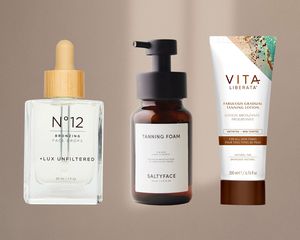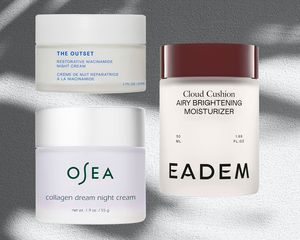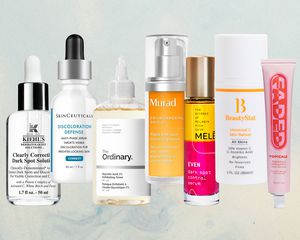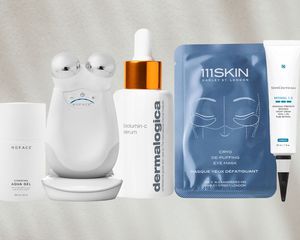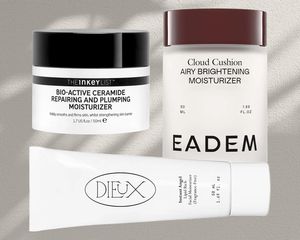There's no shortage of new skincare lines launched by Hollywood stars or influencers these days. As new brands appear on shelves, so do claims of new "star ingredients" and formulas that promise to transform your skin. Collections centered around OG ingredients like salicylic and hyaluronic acid continue to hit the market in tandem with launches based on new botanicals and fruit derivatives you've probably never heard of.
But, what does it mean for newer brands to formulate products based on skin tone, with melanin as the "star" of the show? Does diversity in beauty now mean looking beyond marketing to common skin concerns but categorizing nuances like melanin as well?
Creating products specifically for darker skin tones is vastly different than what it has looked like in the past. The industry experienced a seismic shift with launches like Fenty Beauty by Rihanna when the singer released her line with 40 foundation shades. The offering alone left many brands reevaluating their lineup in the foundation category.
However, the new wave of "melanated skincare" is different from calling existing brands to add more melanin-friendly products to their catalogs, like we see with Aurora James' 15% Pledge and Sharon Chuter's #PullUporShutUp initiative.
Brands like 4.5.6 Skin, Ustawi, and Mele have created products formulated to serve melanated skin, first. However, with a slew of brands adding and improving existing ranges—is a breakout category dedicated to skin of color as impactful? To get a deeper look into the latest push for inclusivity in the skincare aisle, we spoke to leading experts in the skincare space for their spoke on the melanated-focused category.
Meet the Expert
- Dr. Carlos Charles is a board-certified dermatologist who runs his Derma di Colore practice in New York City. He's also the co-founder of 4.5.6 Skin.
- Dr. Michelle Henry is a New York City-based board-certified dermatologist. She runs her own practice, Skin Aesthetics Surgery, and regularly appears in media.
- Noelly Michoux is the co-founder of 4.5.6 Skin and works alongside Dr. Charles to develop their new skincare line.
What Role Does Melanin Play in Our Skin?
To understand the need for skincare explicitly formulated for darker skin tones, we first need to understand melanin's role in the skin. According to Dr. Charles, all skin tones have melanocytes, which are the cells responsible for producing melanin (aka color) that is present on the surface layer of our skin. The melanocytes in darker skin produce more pigment (melanin) than those in lighter complexions. "The size and activity of smaller units in these melanocytes known as melanosomes is a key point of difference in dark skin," Dr. Charles explains. "The melanosomes in melanin-rich skin are more robust and work more efficiently when exposed to the sun or inflammation." This is one of the reasons why darker complexions are more prone to hyperpigmentation by way of acne, trauma, and even eczema, Dr. Charles explains.
The Fitzpatrick Scale is also an important system to note. According to Dr. Charles, the scale (which was introduced in the 1970s) was created in dermatology to categorize skin based on how it reacts to ultraviolet light. "There are six types of skin tone on the scale, one being the lightest, which easily burns when exposed to UV light, and six being the darkest, which typically does not burn in UV light," Dr. Charles explains.
He continues by explaining that melanin and phototype are inextricably linked. Those with phototypes four through six on the Fitzpatrick scale have increased melanosome activity. However, Dr. Charles explains that many skincare development teams typically formulate on phototypes scaling up to three. "Historically, there has been a lack of inclusion and representation in the skincare industry when it comes to treating and caring for darker skin," he says. "This can have a significant negative impact on the approach to treating darker skin because there are nuances that we must consider from the inception to create effective skincare."
Historically, there has been a lack of inclusion and representation in the skincare industry when it comes to treating and caring for darker skin.
How Are Melanin-Rich Skin Tones Different From Others?
Melanin is the determining factor in skin color, making darker skin unique by nature. "The outermost layer of the epidermis of darker skin contains more cell layers than that of lighter skin," Dr. Charles explains. "This structural difference of darker skin can make it more difficult for active ingredients to penetrate skin cells."
Darker skin tones may also have fewer ceramides which are the oils that keep the skin hydrated, Dr. Henry explains, another factor in the overall dryness of skin of color.However, ultimately, both Dr. Charles and Dr. Henry see hyperpigmentation as the most common concern in skin of color. "Melanin-rich skin is susceptible to any form of trauma or inflammation which can lead to recalcitrant hyperpigmentation," Dr. Charles explains. "The inflammation from acne typically leads to hyperpigmentation." Dr. Charles explains.
Dr. Henry adds that redness often goes overlooked as sensitivity in darker complexions. "Some people think that because you can't see redness the same way that you can in lighter skin, darker skin is less sensitive, but that's inaccurate," she explains. "In many ways, it's more sensitive because once we do see redness, it's often followed by hyperpigmentation." Ultimately, it's crucial to treat darker complexions delicately because of their many nuances, not despite them.
Formulating Melanin-Rich Skincare
As the co-founder of 4.5.6 Skin, Dr. Charles says that melanin-rich skincare considers darker skin's specific, unique characteristics (like increased skin layers, sensitivity, and propensity for hyperpigmentation).
"Products for melanin-rich skin are typically formulated with melanocyte-inhibiting agents that help regulate melanin production to minimize excess pigmentation," Dr. Charles explains. "They might also include ingredients that promote epidermal skin cell renewal to promote healthy skin and uniform tones."
Dr. Charles and Dr. Henry agree that when shopping for melanin-friendly skincare, consider a few gently exfoliating ingredients like alpha and beta hydroxy acids as well as hydrating formulas that contain hyaluronic acid and ceramides. Other elements like tranexamic acid and azelaic acid may help treat hyperpigmentation. Ultimately, if you're unsure about the safety or efficacy of a particular product or ingredient, talk to your board-certified dermatologist for the best plan of action.
We are not often taught the basics of caring for melanin-rich skin, and many of us resort to trial and error.
The Melanin-Rich Impact
There have been several strides to create a more diverse and inclusive beauty industry. Still, there's a fine line between bandwagoning trends and true inclusivity, making deciding what products to use and brands to support hard for some consumers.
Therefore it's easy to question the intention of brands that market specifically to darker skin tones using marketing jargon and tactics without speaking specifically to what makes them unique to darker skin. "There's a population of patients that needs care and attention, and they've been neglected for so long. But, we don't want that progress to become trendy instead of serving the patients or customers," Dr. Henry says.
The new wave of melanin-focused brands can change skincare and dermatology alike. Experts and consumers have spoken up about the lack of people of color in documented research, studies, or skin condition photographs—not to mention the lack of diversity amongst board-certified dermatologists. It's why highlighting melanin in the skincare industry can spark the conversations and awareness that finally evokes change.
Noelly Michoux created her 4.5.6. Skin brand to fill a void she noticed early on in life. "White Euro-centric ideals of beauty continue to dominate the mainstream industry, marginalizing the representation of melanin-rich-skinned women, but beauty matters to all women," Michoux says. "We are not often taught the basics of caring for melanin-rich skin, and many of us resort to trial and error."
After networking with industry professionals, Michoux wanted to understand better the link between women of color and the lack of satisfaction with skincare. "I realized most of the skincare industry based its research and development on lighter skin tones," Michoux said.
So, she aimed to create products that didn't exist, and 4.5.6 Skin was born. Michoux and Dr. Charles developed a line of dermatologist-tested products (from cleansers and serums, to targeted treatments) made with skin of color top of mind. Michoux's brand is one of many leading the industry awakening to nix standard skin types and to account for skin of color, which has long gone neglected, despite Black people accounting for over 85% of the spend in the beauty aids category.
While it's exciting to see the skincare industry rise to the occasion, it's important to continuously work to diversify research and development teams across the skincare category to continue making progress.
"I salute this generation of BIPOC women, who are bursting through guardrails and creating space to belong in business," Michoux says. "There's never been a better time for those of us with business aspirations to go for it. By doing so, we are normalizing diversity in the beauty space and creating a world where, as a woman of color, having your needs addressed will become the norm."
:max_bytes(200000):strip_icc()/SFprimary-melanininskincare-146bf0505fb8450da9c0e5443b64c3d6.jpg)


